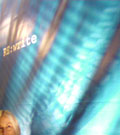
Notes on 'Notes on the Film'
OR My Supermetachat On An Already Metachatty Look @
My Short Documentary, i'm like ...
professional
"i'm like ... professional: notes on the film" announces its desire for the self-sufficiency of the film it contains (the film being, for me, the thing). The Topoi piece emerges from resistance, my resistance to convention, driven by my passionate desire for minimalism and skill in communicating that I trust my audience: "I always appreciate a filmmaker who says little prior to a screening; this, as a way of leaving the film's meaning and interpretation wholly to the viewer." This sentiment obtains. I continue to draw from my desire for brevity and ambiguity, both of which commonly get that audiences don't always need as much as we "give" them.
One of the beautiful aspects of working in new media and especially in Kairos is that publication cycles are fast — ideas circulate among reviewers while the writer is still earnestly thinking and caring about the project rather than merely doing what needs to be done to get the publication. Feedback cycles are compressed in ways that often render editorial comments valuable rather than merely annoying or threatening to a writer. So the writer's range of choices regarding just when/if/how to reply — both to reviewers and, post-publication, to reader comments — may emerge as a productively generative response, one that gives way to new, timely understanding. The shining potential of these contemporary arrangements becomes the thought gift (the generative response) and is not torturously calculated.
Such generous collaboration is special and rare, just as tools for generating work that vibrates with so much potential are precious. We want these. And fortunately, as a tool for publishing in time-compressed media environments, Prezi is nearly ideal. In this Inventio piece, I write about why Prezi works so well (for me), especially in the context of trying to talk about the DIY digital films I have produced. Key concepts that support my claim involve desire and movement (aural, imagistic, spatial). Wander and enjoy, but first, some quick directions:
